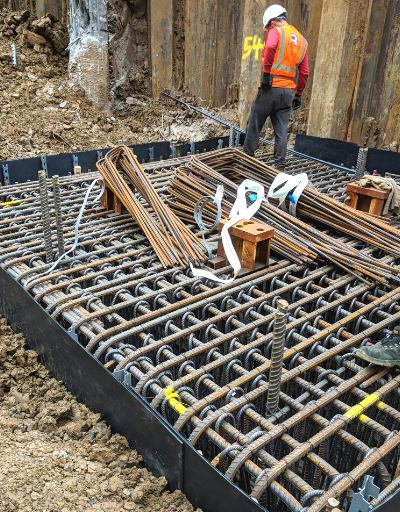Site Investigation and Temporary Works Design
CGL was commissioned by Volker Fitzpatrick to undertake a site investigation and robust temporary works design for the proposed development at The Fitzpatrick Building, located north of Kings Cross, London. The proposed works consisted of demolishing an existing six-storey building and the construction of an eight to nine storey building, with a single basement, supported on piled foundations.
The construction required excavation of around 4.1m in the eastern, northern and western regions of the 20x50m site area, increasing to 6.3m in the central and southern core. A temporary sheet piled wall was installed along all sides of the excavation to support the basement dig and facilitate construction of permanent liner walls. The tightly constrained site has highways situated 4-6m away from the northern and western site boundaries and commercial properties located directly adjacent to the eastern and southern site boundaries. Network Rail and HS2 lines are located approximately 20m south to southwest of the site. AIPs were undertaken by CGL and accepted by Islington and Camden councils.
A ground movement assessment was undertaken using empirical calculations and numerical software to determine potential ground movements associated with the basement excavation and to assess the potential impact these may have on surrounding structures and assets. A detailed load takedown was undertaken for the party wall buildings to accurately and realistically model the existing neighbouring surcharges. CGL provided a Movement Monitoring and Contingency Plan to control ground movements including 3D EDM targets on party wall buildings, 3D EDM targets on the face of the capping beam and walers, and precise leveling targets on the kerbs adjacent to the nearby highways.
Temporary works design for the retaining wall, based on EC7 partial safety factors, consisted of a sheet piled wall supported by one level of horizontal props at high level. Numerical analyses to determine design loads, required wall depth for rotational stability, wall deflections and unfactored wall forces was undertaken. Steel members, including props and walings were designed using CADS A3D software, including a frame analysis, by using the waling forces derived from the WALLAP analysis.
CGL’s working platform designs for a piled tower crane base and several scaffold design checks were all signed off by Network Rail with no further queries raised by Camden and Islington Councils.


